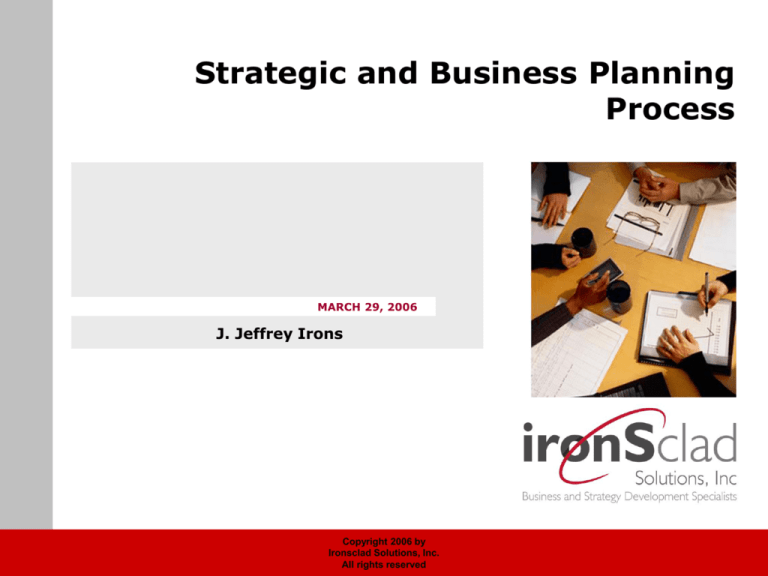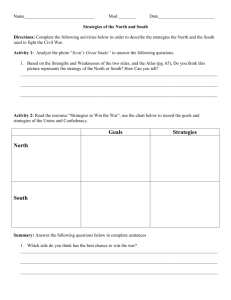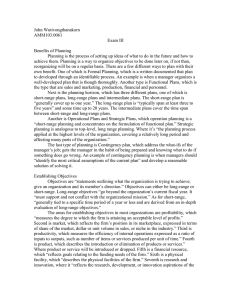
Strategic and Business Planning
Process
MARCH 29, 2006
J. Jeffrey Irons
Copyright 2006 by
Ironsclad Solutions, Inc.
All rights reserved
Business Development Process Tools
Short Strategic Plan (10 Pages or Less)
Must Have Your Vision Clearly Stated for All
Market “Space” Defined
Opportunities Briefly Outlines
How are we Going to “Get There”
Focus
Targets
No “Pop-Ups” to get rich quick
Finances are Important, but Aren’t the Vision
Everyone must Understand the Vision/Plan
2
Copyright 2006 by
Ironsclad Solutions, Inc.
All rights reserved
Business Development Process Tools (Cont.)
Opportunity Qualification Process (12 Questions)
All New Business Opportunities Must Go Through this Gate
Fits with the Strategic Plan
Answers the 12 Questions Before the Pursuit
Capture Plan (3 Pages)
What You Plan to do Over the Next 30-60 Days
Briefings, Meetings, White Papers, Legislative, Others
Weekly Communications (1 Page or Less)
Weekly Report
Status of the Capture Plan, Actions, What You Did This
Week, and What You Plan to Do Next Week
Other Resources
3
Copyright 2006 by
Ironsclad Solutions, Inc.
All rights reserved
The Executive Steering Team’s (EST) Role
Set the Strategic Direction by establishing Vision, Mission,
Values, and a Philosophy of Management
Be loyal to the Strategic Direction and communicate it to the
organization
Be loyal to one another in establishing management systems to
effect the Strategic Direction, including resource allocation and
accountability for their use and mis-use
Protect the assets of the company through the development of
comprehensive policies, when required
Perform external and internal environmental scans for Strengths,
Weaknesses, Opportunities and Threats
Review Strategic performance
Receive and communicate feedback from the governing bodies,
customers and marketplace, key suppliers and partners, and the
organization
4
Copyright 2006 by
Ironsclad Solutions, Inc.
All rights reserved
Strategic Planning Direction
Developing the Operating Values
The Values (or Guiding Principles) explicitly state what the
organization intends and expects. They serve as standards for
judging both organization policies and actions and individual
conduct. They also define the organization’s position and serve
as a cornerstone for culture-building.
The Values could be;
Loyalty - Bear true faith and allegiance to the company, its operating
units, support organizations, and the Group itself.
Duty - Fulfill your obligations.
Respect - Treat all people with dignity and respect.
Selfless Service - Put the welfare of the company, its operating
units, TBE support organizations, and the Group itself, before your
own.
Integrity - Do what’s right; legally, morally, and ethically.
Personal Courage - Be bold, honest, and steadfast.
Honor -Live up to all the Values.
5
Copyright 2006 by
Ironsclad Solutions, Inc.
All rights reserved
Strategic Planning Process
Purpose Documents
Vision - Mission - Values - Philosophy
Environmental Scan
Internal and External Business
(SWOT Analysis)
Strengths
Weaknesses
Opportunities
Threats
Executive Steering
Team (EST) Analysis
EST Sets Strategic Direction
Strategies, Goals, Objectives, Measures
Implementation
Action Plans, Resources, Accountability
Review and Analysis
6
Annual Planning Process
Quarterly
Copyright Reviews
2006 by
Ironsclad
Solutions,
Monthly StatusInc.
All rights reserved
Values or Guiding Principles
Ethically promoting the company’s place with current and future
customers, while focusing on and protecting our core competencies.
7
Copyright 2006 by
Ironsclad Solutions, Inc.
All rights reserved
Strategic Planning Direction
Developing the Vision and Mission
The Vision describes what business the organization plans
to be.
The Mission describes the activities and responsibilities of
what the organization does and what sets it apart from
others.
To do this we must determine and agree on;
The Products and Services,
The Customers,
Describe what the Products and Services Do,
Describe the Unique Attributes of the Company that Sets it
Apart From Others in the Same Field, and
Now, we will compose a paragraph or a set of sentences that
Summarize the Vision and Mission based upon the above
information
8
Copyright 2006 by
Ironsclad Solutions, Inc.
All rights reserved
Key Products and Services
Defined by You
9
Copyright 2006 by
Ironsclad Solutions, Inc.
All rights reserved
Key Products and Services
EXAMPLES
Market Intelligence
Customer Interface
Strategic Planning
Business Opportunities
Customer Contacts
Proposal Management
Public Relations Management
10
Copyright 2006 by
Ironsclad Solutions, Inc.
All rights reserved
Strategic Planning Direction
Identifying the Stakeholders and Expectations
Stakeholders are defined as anyone who has a stake in
how well the organization achieves its mission.
It
normally includes the members of the organization, its
customers, suppliers, and shareholders.
List all Stakeholders involved in your operation or
organization.
Identify Stakeholder Expectations
Define What Each Stakeholder Expects From the
Company
If you don’t know what their expectations are, talk
to them and find out. This can be accomplished by
direct discussions, interviews, and questionnaires.
11
Copyright 2006 by
Ironsclad Solutions, Inc.
All rights reserved
Strategic Planning Direction
Identifying the Stakeholders and Expectations
List all Stakeholders involved in your operation or
organization.
12
Copyright 2006 by
Ironsclad Solutions, Inc.
All rights reserved
Unique Attributes of the Group
EXAMPLE
A consolidated New business development team that is situated
at the executive level of the company.
An executive group that is attuned to New business and
advocates its perpetuation
An autonomous New Business Development budget.
No obvious answers. Some strengths in cold calling and the fact
that we have a hands on role can be discussed
Many have a strong technical as well as business development
background.
Customer and market knowledge -- a thorough understanding of
the customers' requirements/needs/budget/priorities.
Customer relationships -- we know who to talk to when there are
questions on how to develop winning strategies.
Capabilities -- we understand the entire spectrum of capabilities
offered by the entire company
13
Copyright 2006 by
Ironsclad Solutions, Inc.
All rights reserved
The Vision
What do we want the organization to
become?
14
Copyright 2006 by
Ironsclad Solutions, Inc.
All rights reserved
The Mission
What does the organization do?
15
Copyright 2006 by
Ironsclad Solutions, Inc.
All rights reserved
Strategic Planning Direction
Define the Key Results Areas
Key Results Areas are defined as any area which you must
be successful in order to accomplish the Mission.
Based on the Stakeholders and Their Expectations, Define
Key Results Areas, Grouping them into Major Headings
Try to keep the number of Headings between five and ten
16
Copyright 2006 by
Ironsclad Solutions, Inc.
All rights reserved
Strategic Planning Direction
Identify the Critical Issues
Critical Issues are defined as any issues that
may affect your ability to deliver on the Key
Results Areas and accomplish the Mission.
Each member of the group needs to write down the
Critical Issues that they feel will be Key to achieving
the Key Results Areas previously identified as those
that will determine the success of the Company in the
next 2 years.
Each member of the group needs to write down the
Company Strengths, Weaknesses, Opportunities, and
Threats (SWOT)
Develop a Group List
Group the Issues into Headings of Major Importance
and reduce to five to ten Headings
17
Copyright 2006 by
Ironsclad Solutions, Inc.
All rights reserved
Internal Strengths
EXAMPLES
Certain members have the experience to bring a "big
company" perspective to the company.
Generally, a whole lot of enthusiasm among the members and
a good technical depth as well.
Cooperation. The group wants to work together.
Discipline. We have the processes in place necessary to win
new business, and necessary to show interested employees
what is required to win this business.
Knowledge of customer trends/needs
Knowledge. The group knows how to win new business.
Customer contact base
Proactive attitude
18
Copyright 2006 by
Ironsclad Solutions, Inc.
All rights reserved
Internal Weaknesses
EXAMPLES
Insensitivity towards the culture
Prioritization
Competitior knowledge
Poor leverage of the company
Lack of Discretionary Resources.
Misaligned compensation plans.
Eternal eye to the current quarters' (or year end's at most) bottom line
that discourages long-term vision and investment.
Still tend to view everything from a division perspective, rather than the
company. Have spent a year haggling over how to share revenues from a
multiple-award contract. I'm not sure they've arrived at an answer yet.
19
Copyright 2006 by
Ironsclad Solutions, Inc.
All rights reserved
External Opportunities
EXAMPLES
I would look for opportunities to work with other local companies
I've been struggling with this one since I joined the company 10 months
ago.
Emergency Response
Nuclear Resurgence
A Simplification of the amount, and complexity of software tools that are
used. (Win-award, forms, etc.)
Redundancies in products purchased within different organizations that
are not shared with other groups.
20
Copyright 2006 by
Ironsclad Solutions, Inc.
All rights reserved
External Threats
EXAMPLES
The company’s eroding business base
The hemorrhage of company talent to competitors
While being a small company, the company is extremely rigid
and does not adapt to business changes very well.
A refusal to accept a lesser role in major efforts (such as
subcontracting to a competitor). We seem to go for all or
nothing far too often.
Company's welfare is so dependent on one customer.
Program cutbacks and realignments. Our biggest threat is our
biggest customer, and how they perceive their work vs. our role.
21
Copyright 2006 by
Ironsclad Solutions, Inc.
All rights reserved
Strategic Planning Direction
Identify the Critical Issues
Critical Issues are defined as any issues that may affect
your ability to deliver on the Key Results Areas and
accomplish the Mission.
What are the obstacles or impediments that lie in the path of
the success?
22
Copyright 2006 by
Ironsclad Solutions, Inc.
All rights reserved
Strategic Planning Direction
Develop the Goals
A Goal is a statement of long-range (1-5 years)
intentions for a specific aspect of the
organization.
Review the Critical Issues and ask what has to be done
to meet the challenge of each of the Major Issue
Groups.
Develop at least one Long-Range Goal for each Major
Critical Issue Group
Establish an Owner of the Goal from the EST who will
be responsible for its achievement.
Try to limit the number of goals to 8 or less.
A goal should state “what” should be done and “why”!
23
Copyright 2006 by
Ironsclad Solutions, Inc.
All rights reserved
Strategic Planning Direction
Develop the Goal’s Objectives
An Objective is a statement of short-range
measurable initiatives that support the Goals.
Review each Long-range Goal and develop one or more
short-range Objectives that will enable the organization
to reach the goal.
Ensure that each Objective contains language that
indicates when the objective has been met and who is
responsible.
An Objective should state how much, when, and
annotate who!
24
Copyright 2006 by
Ironsclad Solutions, Inc.
All rights reserved
Strategic Planning Direction
Develop the Goal’s Objectives
An Objective is a statement of short-range measurable
initiatives that support the Goals.
An Objective should state how much, when, and annotate
who!
25
Copyright 2006 by
Ironsclad Solutions, Inc.
All rights reserved
Strategic Planning Direction
Develop the Objectives’ Action Plans
An Action Plan describes those activities that must be
accomplished in order to meet a specific Objective.
Identify the Goal and Objective to which the Action Plan is
linked
Identify who is responsible for ensuring that the Objective is
met. This can be an individual or Team.
List all the activities that must be met along with completion
dates and responsible individuals.
Include Performance Indicators such as schedule, quality,
productivity, etc. that will be used to determine successful
completion of the activities
Include Performance Measures for each Indicator to measure
the level of Action Plan completion
26
Copyright 2006 by
Ironsclad Solutions, Inc.
All rights reserved
Strategic Planning Direction
Develop the Objectives’ Action Plans
An Action Plan describes those activities that
accomplished in order to meet a specific Objective.
must
be
An Action Plan answers the questions; what, who, when, and how
and specifies Performance Measurement Indicators to determine
successful completion of the Action Plan and Measures to indicate the
level or degree of completion.
27
Copyright 2006 by
Ironsclad Solutions, Inc.
All rights reserved
Strategic Planning Direction
Review and Revise the Document Regularly
Due to the dynamic nature of economic, social, political,
technological and other factors; strategic planning must be done
on a continual basis.
A Strategic Plan is a living document and in order for it to remain
alive, it must receive a lot of attention, be nurtured, satisfied,
and fulfilled. A Strategic Plan developed in June may be obsolete
in September, therefore, it must be revisited and revised on a
regular basis or when changing conditions dictate.
28
Copyright 2006 by
Ironsclad Solutions, Inc.
All rights reserved
Conclusions
Usually, the Best Solution will be Chosen
If the Solutions are Similar, Other Factors may
Impact the Decision
Customer Relationships may Give you the
Information Essential to Gain Insight for any
Problem/Program of Interest
May be the Difference Needed to Win the Program
Customer Relationships and Marketing do not
Take the Place of Doing a Great Job
Excellent Program Performance is a Requirement
Do What You Enjoy – Life is a Marathon, not a
Sprint
You are in this for the “Long Haul”
29
Copyright 2006 by
Ironsclad Solutions, Inc.
All rights reserved






